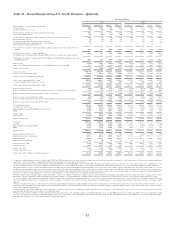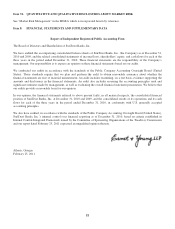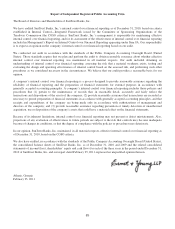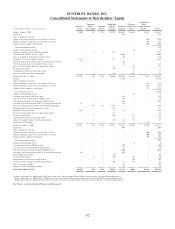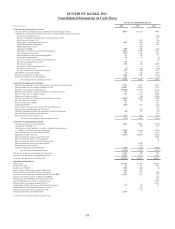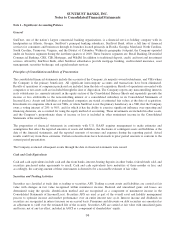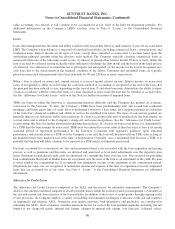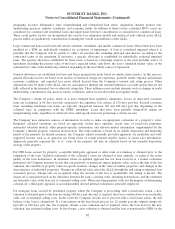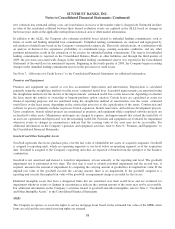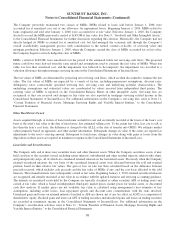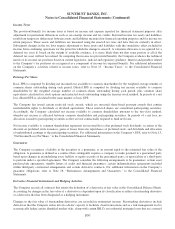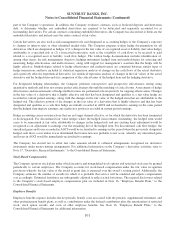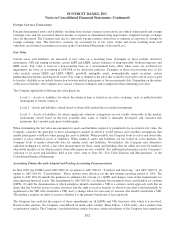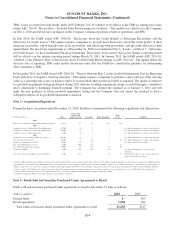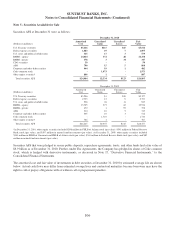SunTrust 2010 Annual Report Download - page 113
Download and view the complete annual report
Please find page 113 of the 2010 SunTrust annual report below. You can navigate through the pages in the report by either clicking on the pages listed below, or by using the keyword search tool below to find specific information within the annual report.SUNTRUST BANKS, INC.
Notes to Consolidated Financial Statements (Continued)
geographic location, delinquency rates, nonperforming and restructured loan status, origination channel, product mix,
underwriting practices, industry conditions, and economic trends. In addition to these factors, refreshed FICO scores are
considered for consumer and residential loans and single name borrower concentration is considered for commercial loans.
These credit quality factors are incorporated into various loss estimation models and analytical tools utilized in the ALLL
process and/or are qualitatively considered in evaluating the overall reasonableness of the ALLL.
Large commercial nonaccrual loans and certain consumer, residential, and smaller commercial loans whose terms have been
modified in a TDR are individually identified for evaluation of impairment. A loan is considered impaired when it is
probable that the Company will be unable to collect all amounts due, including principal and interest, according to the
contractual terms of the agreement. If necessary, a specific allowance is established for individually evaluated impaired
loans. The specific allowance established for these loans is based on a thorough analysis of the most probable source of
repayment, including the present value of the loan’s expected future cash flows, the loan’s estimated market value, or the
estimated fair value of the underlying collateral depending on the most likely source of repayment.
General allowances are established for loans and leases grouped into pools based on similar characteristics. In this process,
general allowance factors are based on an analysis of historical charge-off experience, portfolio trends, regional and national
economic conditions, and expected loss given default derived from the Company’s internal risk rating process. Other
adjustments may be made to the ALLL after an assessment of internal and external influences on credit quality that are not
fully reflected in the historical loss or other risk rating data. These influences may include elements such as changes in credit
underwriting, concentration risk, macroeconomic conditions, and/or recent observable asset quality trends.
The Company’s charge-off policy meets or is more stringent than regulatory minimums. Losses on unsecured consumer
loans are recognized at 90 days past due compared to the regulatory loss criteria of 120 days past due. Secured consumer
loans, including residential real estate, are typically charged-off between 120 and 180 days past due, depending on the
collateral type, in compliance with the FFIEC guidelines. Loans that have been partially charged-off remain on
nonperforming status, regardless of collateral value, until specific borrower performance criteria are met.
The Company uses numerous sources of information in order to make an appropriate evaluation of a property’s value.
Estimated collateral valuations are based on appraisals, broker price opinions, recent sales of foreclosed properties,
automated valuation models, other property-specific information, and relevant market information, supplemented by the
Company’s internal property valuation professionals. The value estimate is based on an orderly disposition and marketing
period of the property. In limited instances, the Company adjusts externally provided appraisals for justifiable and well-
supported reasons, such as an appraiser not being aware of certain property-specific factors or recent sales information.
Appraisals generally represent the “as is” value of the property but may be adjusted based on the intended disposition
strategy of the property.
For CRE loans secured by property, acceptable third-party appraisal or other form of evaluation is obtained prior to the
origination of the loan. Updated evaluations of the collateral’s value are obtained at least annually, or earlier if the credit
quality of the loan deteriorates. In situations where an updated appraisal has not been received or a formal evaluation
performed, the Company monitors factors that can positively or negatively impact property value, such as the date of the last
valuation, the volatility of property values in specific markets, changes in the value of similar properties, and changes in the
characteristics of individual properties. Changes in collateral value affect the ALLL through the risk rating or impaired loan
evaluation process. Charge-offs are recognized when the amount of the loss is quantifiable and timing is known. The
charge-off is measured based on the difference between the loan’s carrying value, including deferred fees, and the estimated
net realizable value of the loan, net of estimated selling costs. When assessing property value for the purpose of determining
a charge-off, a third-party appraisal or an independently derived internal evaluation is generally employed.
For mortgage loans secured by residential property where the Company is proceeding with a foreclosure action, a new
valuation is obtained prior to the loan becoming 180 days past due and, if required, the loan is written down to net realizable
value, net of estimated selling costs. In the event the Company decides not to proceed with a foreclosure action, the full
balance of the loan is charged-off. If a loan remains in the foreclosure process for 12 months past the original charge-off,
typically at 180 days past due, the Company obtains a new valuation and, if required, writes the loan down to the new
valuation, less estimated selling costs. At foreclosure, a new valuation is obtained and the loan is transferred to OREO at the
97


